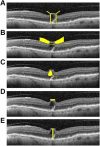Pneumatic Vitreolysis With Intravitreal Air for Focal Vitreomacular Traction
- PMID: 37007599
- PMCID: PMC9976235
- DOI: 10.1177/2474126420962649
Pneumatic Vitreolysis With Intravitreal Air for Focal Vitreomacular Traction
Abstract
Purpose: To determine whether pneumatic vitreolysis with intravitreal air is effective for focal vitreomacular traction (VMT).
Methods: We conducted a retrospective consecutive case series of 20 eyes from 19 individuals with focal VMT who underwent pneumatic vitreolysis with intravitreal air (January 2017 to November 2018). We analyzed patients via spectral-domain optical coherence tomography before intravitreal air injection and at 1 month. The primary outcome measure was release of VMT.
Results: We observed release of VMT in 55% of individuals. An analysis limited to phakic eyes demonstrated release of VMT in 69%, and 65% developed improved best-corrected visual acuity. Individuals with persistent VMT and visual improvement had a significant reduction in angle of vitreoretinal insertion (P < .01), area under VMT (P < .05), and subfoveal cyst area (P < .05).
Conclusions: Intravitreal air is an effective treatment for focal VMT. In individuals with persistent VMT, visual-acuity improvement was associated with a reduction in overall VMT.
Keywords: intravitreal air; pneumatic vitreolysis; vitreomacular traction.
© The Author(s) 2020.
Conflict of interest statement
The author(s) declare no conflict of interest with respect to the research, authorship, and/or publication of this article.
Figures





References
-
- Folk JC, Adelman RA, Flaxel CJ, Hyman L, Pulido JS, Olsen TW. Idiopathic epiretinal membrane and vitreomacular traction Preferred Practice Pattern® guidelines. Ophthalmology. 2016;123(1):P152–P181. doi:10.1016/j.ophtha.2015.10.048 - PubMed
-
- Duker JS, Kaiser PK, Binder S, et al. The International Vitreomacular Traction Study Group classification of vitreomacular adhesion, traction, and macular hole. Ophthalmology. 2013;120(12):2611–2619. doi:10.1016/j.ophtha.2013.07.042 - PubMed
-
- Tzu JH, John VJ, Flynn HW, et al. Clinical course of vitreomacular traction managed initially by observation. Ophthalmic Surg Lasers Imaging Retin. 2015;46(5):571–576. doi:10.3928/23258160-20150521-09 - PubMed
-
- Patron ME, Baumal CR, Rogers AH, et al. Anatomic and visual outcomes of vitrectomy for vitreomacular traction syndrome. Ophthalmic Surg Lasers Imaging. 2010;41(4):425–431. doi:10.3928/15428877-20100525-07 - PubMed
-
- Dugel PU, Tolentino M, Feiner L, Kozma P, Leroy A. Results of the 2-Year Ocriplasmin for Treatment for Symptomatic Vitreomacular Adhesion Including Macular Hole (OASIS) randomized trial. Ophthalmology. 2016;123(10):2232–2247. doi:10.1016/j.ophtha.2016.06.043 - PubMed
Publication types
LinkOut - more resources
Full Text Sources

